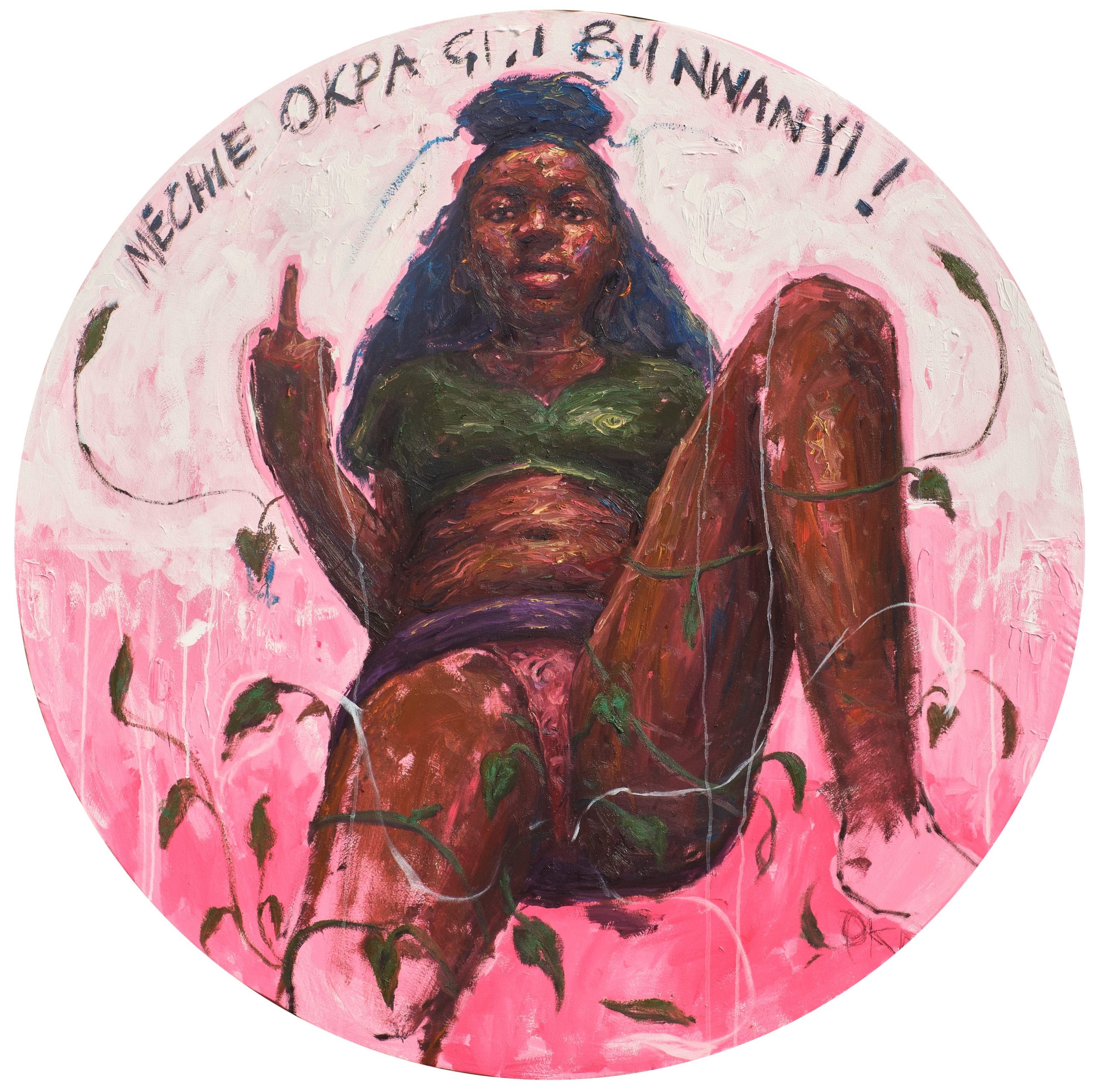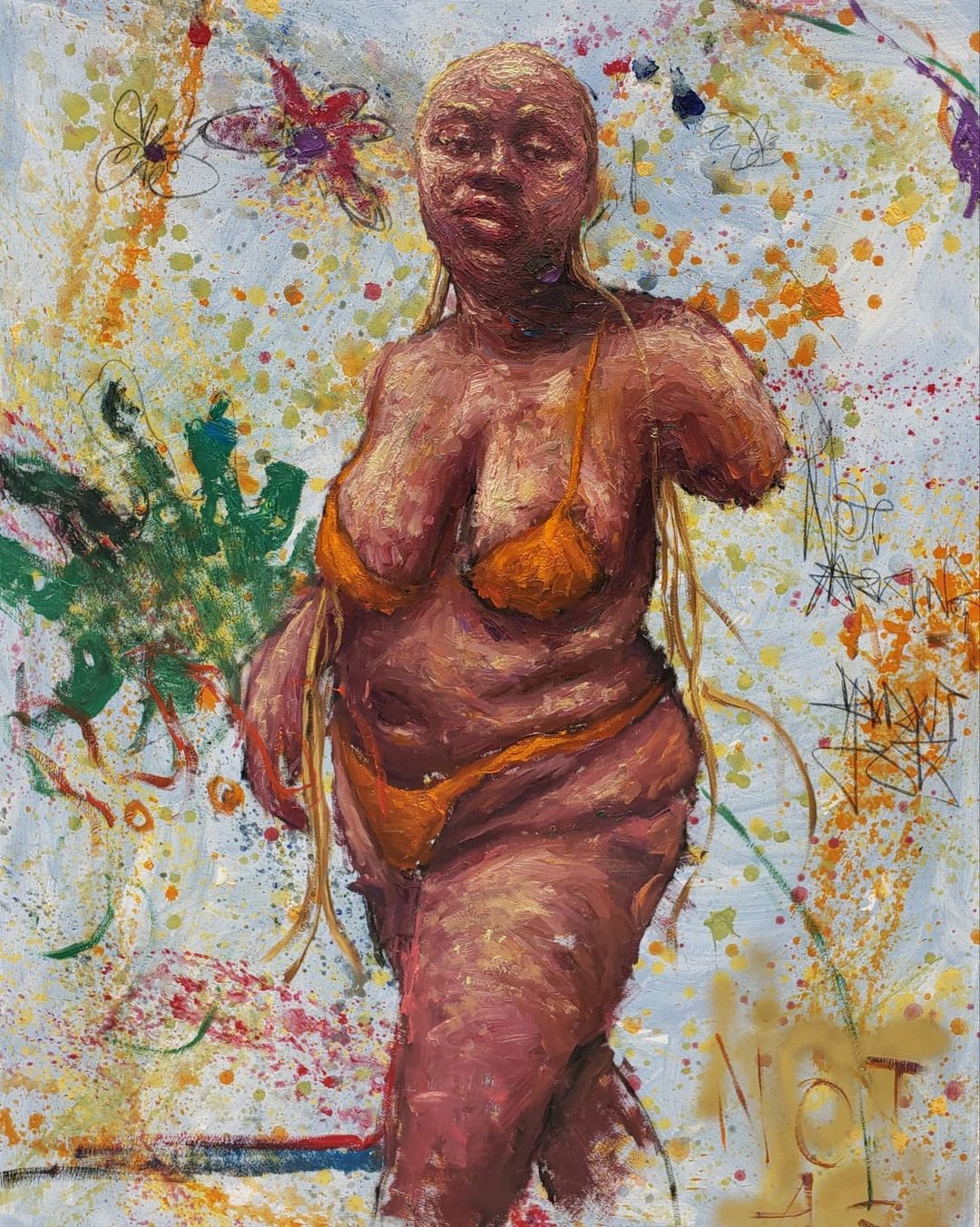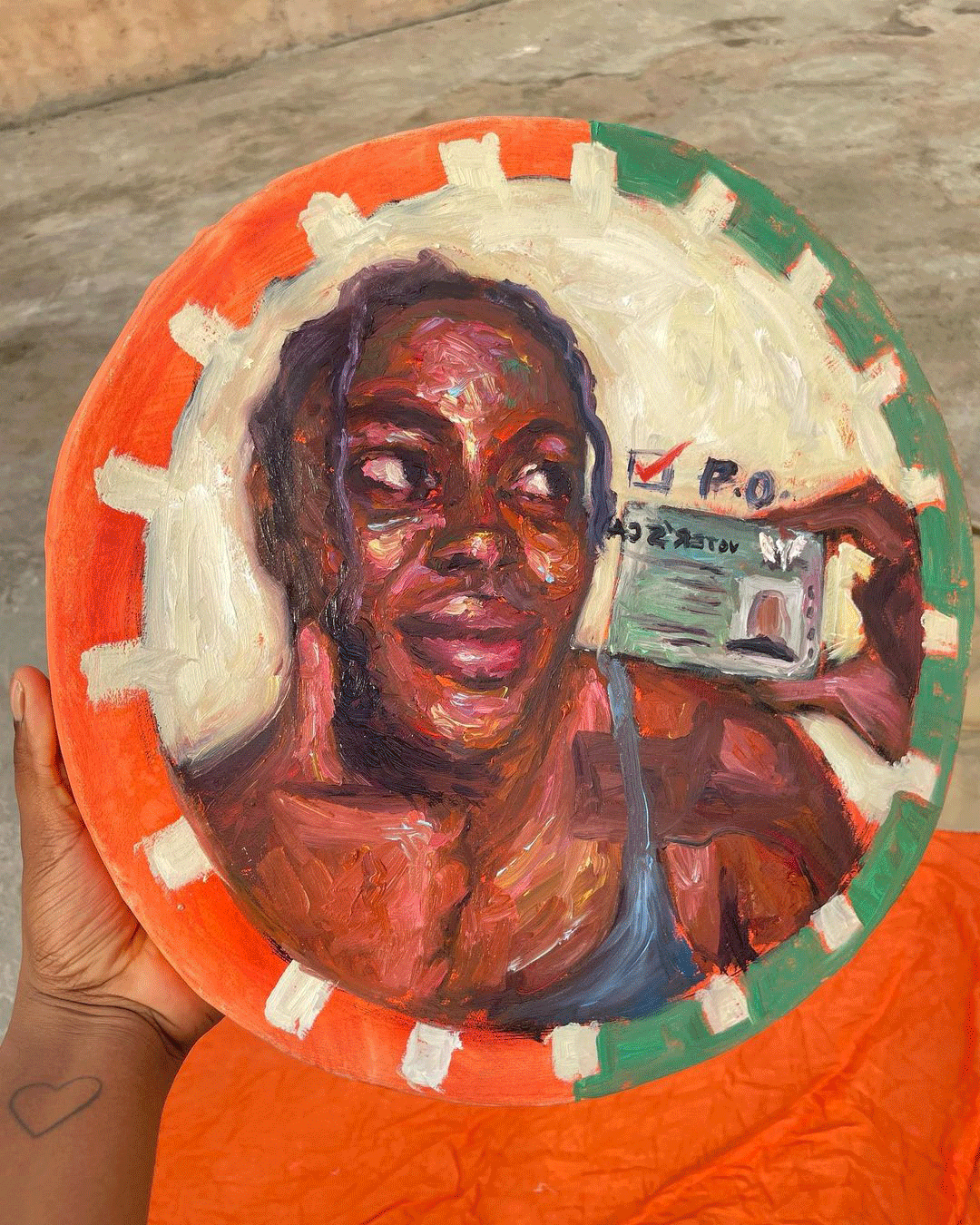In a world where women are told all the things they can or cannot do, Chigozie Obi’s art creates a realm where women exist in unbounded freedom. Bleeding, smoking, staring into space: we are ushered into a world where women can just be.
Her eyes are solute and unshaken. Her middle finger is gallant in its elevation. The woman in the painting is the very embodiment of defiance: legs spread wide open, a sliver of pink lace staring us in the face. Above her head is a sentence written in Igbo: ‘Meche okpa gi i bu nwanyi. Close your legs, you are a girl,’ something the artist heard time and time growing up, epithets hurled at women telling them what they can and cannot do. As she ushered this painting into being, every hue mixed, every brush stroke, every pencil drawing is a vehement rebuttal to the containment of women. The muse—with her blue hair, deep olive green crop top baring the warm skin of her belly does not smile—does not close her legs, does not shrink herself. She opens like a garden, fierce and ready to bloom.
JANUARY 17TH 2023
On the afternoon I am to meet Chigozie Obi on the rooftop at Bogobiri, a small boutique hotel in Ikoyi, the entire length of Awolowo Road is locked in standstill traffic as is customary of Lagos. Throughout the past year, I have admired her work for its rawness and vulnerability and her, for her style and vibrance. Deeply moved by the ways her art challenges fatphobic beauty standards, similar to the essays I write, I have always felt a certain kinship in our work and I am keen to share space with her.
I arrive at the hotel finally, an hour and a half after our planned meeting and as I climb the steep spiral stairs up to the Bogobiri rooftop, I revel in its time-travelling nature, how being there always feels like stepping into another time. The walls are lined with old brown shelves interspersed with tiny sculptures and paintings. The couches are upholstered with old aso oke, lines of pale purple and blue adorning the bodies of the couch, one of which Chigozie is seated on. She rises from the seat with a bright smile on her face and gives me the warmest hug as we laugh and complain about the traffic and the general craziness that is Lagos at this time of the year.
The award-winning artist is wearing a pastel blue crop top and a khaki miniskirt with minimalist tattoos peppered along her forearms and her mouth is perpetually poised in a smile on the edge of laughter. As we meander through pleasantries, she whips out her phone to photograph our surroundings for her Instagram stories. Observing her unyielding dedication to documenting her surroundings, we begin to discuss Le Journal De Gozie, a visual diary of her daily life. She tells me: ‘I started being more intentional with documentation when I lost my mum in 2019 and I realized that I only had two or three pictures with her.’ Her face softens as she talks about her mother, whose name is tattooed on her forearm, smiling a little sadly saying, ‘I think you heal forever when you lose a loved one.’ Her grief birthed in her a renewed dedication to capturing life both in its spectacular and mundane moments, celebrating the beauty of existence: a principle that has monumentally shaped her creative praxis.
As we settle into the conversation, Chigozie beams with excitement and a quiet, pleased self-assurance telling me it’s been quite the journey, quite the year. Born on the 13 of November 1997 at St. Nicholas Hospital in Ikeja, Lagos, she holds a degree in Fine Art from the University of Lagos but is quick to state that the teachings were mostly theoretical and that it is in the real process of self-exploration and experimentation that an artist is born. ‘Personally, I don’t believe anybody is self-taught. As long as you learnt from something or someone, whether an institution or a person, you were taught.’ In her third year of industrial training (part of the degree where students must undertake real work in their respective industries), she worked at Universal Studio, Iganmu from 2015 to 2016. This was the place where her mind for art awakened and even outside the required timetable and schedule of her tutors, she continued to mix colours and experiment with techniques on her own time.
She tells me that right after finishing university at the age of 20, most of her work was just ‘practice and practice’ without any focus on exhibition. Just hours and hours and hours of painting. She tells me: ‘In the beginning, perfection was an important aspiration in my practice.’ This was combined with the tendency to mindlessly imitate her tutor but halfway through, she stopped going to his studio and began to forge her own style and her own voice. Observing this, a mentor gently guided her into using her work as a means of expressing the things that were important to her. With a look both earnest and certain, she says: ‘Art is a great way to talk to a large number of people at once.’
ARTISTIC INFLUENCE
And with her large and ever-growing social media presence, the power of her art is further amplified by her audience. Just a few days before our meeting, she posted a painting she made of herself, holding her Permanent Voter’s Card (PVC). This use of art as a medium of activism is not new to her. In October 2020 when Nigerian youths made their voices heard against the extra-judicial killings in the EndSARS protest, Chigozie Obi was one of many artists who painted on canvases at protest grounds, adding their art to the chorus of voices.
Speaking on the PVC painting, she acknowledged her power and positionality, telling me: ‘You never know the person who will see a painting of me and go and get their PVC as well. Art must always come from what you believe in,’ she says, ‘I want to stay in Nigeria, I want to live here and because of this, I am involved in the political realities that are being shaped and in my own way my work has joined the chorus of voices fighting for something real.’ The year before, she had been awarded the Access Bank Art X Prize 2021, alongside a three-month residency at Gasworks, London. Although she enjoyed the adventure of a new place, she shares with me that her time there cemented her desire to live and work in Nigeria, a place where she could be wholly herself, without pandering to anyone.
WHAT DOES IT MEAN TO BE A WOMAN?
Becoming moved by the truth behind her words, she goes on to say: ‘I am very passionate about women’s issues. I’m protesting here and there, always ready to fight for women’s rights.’ She is more than a worthy opponent. This commitment to women starts with a well-settled gaze on the self, as she informs me ‘I am the person I have painted the most.’ As a nonfiction writer whose work comes from my lived experiences, this resonates strongly with me and my long-held principle that the self is a worthy muse. For her, this merely started from a place of convenience: she just needed someone to pose and paint without leaving the studio.
But this quickly morphed into something more powerful: using her life as art to spread awareness of the intricacies and internalities of life, especially on topics people would rather shy away from. For instance, her 2023 painting ‘Pain, Stains and Positions’, showing at C+N Gallery in Genoa, Italy, depicts a young menstruating woman, painted with petals of blood as the pains of menses cause her to contort herself. The woman could very easily be Chigozie herself and she shares that, ‘it can be scary to be so open and vulnerable with your life in that way, to paint and for people to find your face in that painting, to know it is YOU.’ She pushes past that fear or discomfort, inviting people into her pain so that they know they are not alone. More than that, it is a celebration of self, she laughs saying, ‘na one face you get, na one body you get, you better love it!’ At the heart of Chigozie’s praxis is a celebration of life and of bodies, in all the forms that they come. On celebrating the multiplicities of women’s bodies, she says:
I am very intentional about being inclusive with my work. Women who are fat, slim, tall, short, people living with disabilities, people living with albinism. I want people to find themselves in my work. Being a tall woman, I know the power of representation and I want my work to wield that same power.
Whenever I reach out to women, it is so beautiful to see how happy they are to be included and to be represented in my work. Especially in preparation for my ‘Coming Up For Air’ series. I have been doing my work to embody the human experience across all categories. My commitment to diversity is pulled from my real life, from experiencing people and valuing them no matter how they look. I know their stories are important. Anybody can become art. All of us must work on creating safe spaces for ourselves.
She goes on to say that someone once told her that the people she paints are not ‘beautiful’. I understand the sentiment behind that statement only because I know what ‘beauty’ means to most people: manicured appearances and ‘goodness’. But Chigozie’s work is full of haunting faces, heavy people, and people carrying things. She agrees with the person’s statement because, for her, the beauty that comes at the cost of blurring painful realities is not the truth of art. She says: ‘I want people to look at my paintings and ask, “What is this person going through?”’. Chigozie’s work is full of ‘bad women’, women who smoke, sex workers, fat women and bleeding women—all free from the shackles of proprietary and performance. This is shown even in her technique and the way these beings are rendered in paint. As Chigozie laughingly says: ‘I’m a fast painter, sometimes I don’t even finish my hands.’ She is an artist who is not after portraying perfection, it does not have to be all put together. ‘I feel a burden to show the imperfections of life, to not sanitize life’s experiences, especially when it comes to the lived experiences of women.’ As a writer, I have a deep and sustained obsession with portrayals of ‘bad women’ in literature, of women who are unbound and not weighed down with goodness, and this was the very same thing that drew me to Chigozie’s work.
A few months before our meeting, Chigozie had reached out to me to write an accompanying text for her painting, ‘THE WRITER’, from her collection titled A Seat At The Table showcasing women in different industries. After being mistaken for a man so many times in her career, because of how ‘strong’ her work appeared, this collection boldly depicts women working, in all endeavours. Upon seeing that painting with the woman bent over a desk, her face poised in steep concentration, her pen held with silent strength, I immediately saw myself. I saw the power I wield. For me, that is what is at the heart of Chigozie’s work; it is a place where women can see themselves, both liberated and empowered. Shrugging of notions of propriety, spreading their legs as wide as they would like, sending a middle finger to every single voice that spews subjugation and mockery. WE ARE FREE. That is the message every stroke of paint in her work is screaming into this world.
Works by Chigozie Obi / Courtesy of the Artist
As our discussion nears its end, she tells me she’s going off to see some of her friends and the joy on her face morphs quickly into a deep affection as she tells me how the women in her life enrich it beautifully. ‘I don’t shy from the I-love-yous, community is the bedrock of who I am.’ Her face lights up with a smile as she says ‘Yadi is my sis. Nengi is my sis.’ On a final note she says, women must know who they are for themselves, not in relation to anyone else. She says to herself: ‘Chigozie, you are a person—society must come to the realisation that we women are who we are and that we belong to ourselves. I want women to just be.’ On the future of her work, she says: ‘Right now, I am in a place where freedom in my work is my greatest aspiration. I want to let go of the exactitude and principles of art. Let it flow.’ Within her is a constant need to do more with material. She says: ‘What can I do that will make me feel like I am using a lot of my brain and my heart into this work? You must grow. As an artist, you have to show growth, and freedom is the way into that growth.’⎈
The views, thoughts, and opinions published in The Republic belong solely to the author and are not necessarily the views of The Republic or its editors. We want to hear what you think about this article. Submit a letter to the editors by writing to [email protected].





